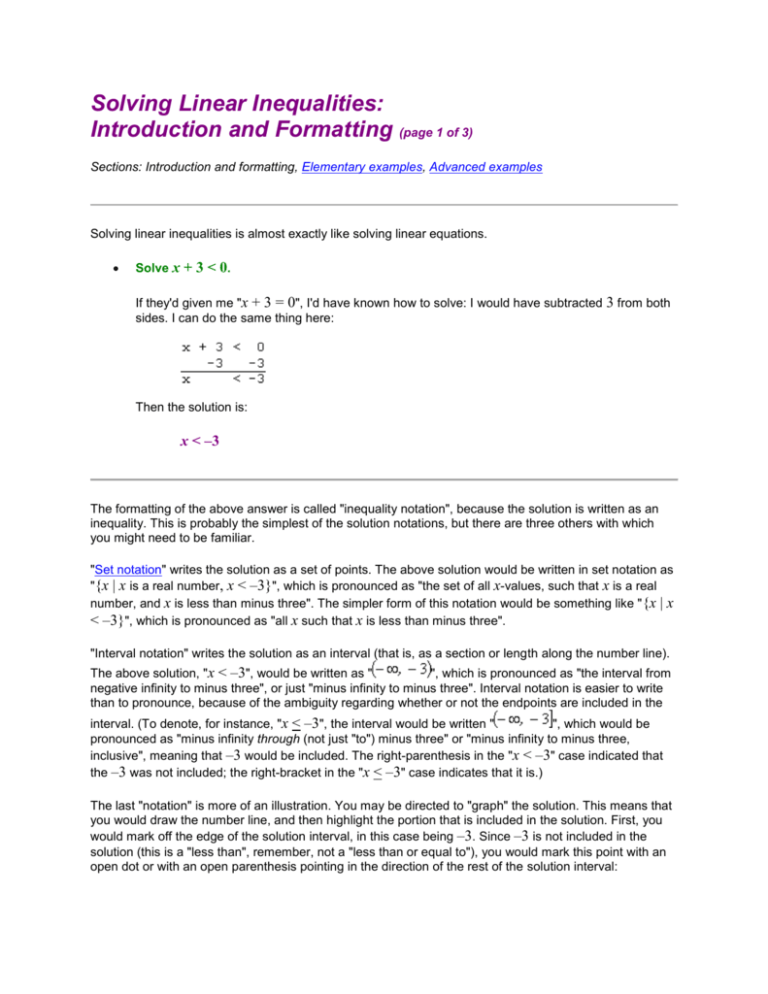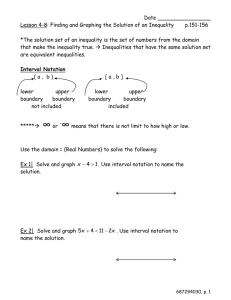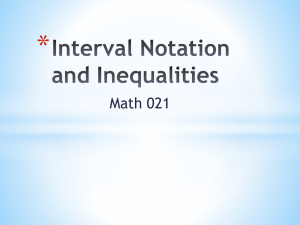
Solving Linear Inequalities:
Introduction and Formatting (page 1 of 3)
Sections: Introduction and formatting, Elementary examples, Advanced examples
Solving linear inequalities is almost exactly like solving linear equations.
Solve x
+ 3 < 0.
If they'd given me "x + 3 = 0", I'd have known how to solve: I would have subtracted
sides. I can do the same thing here:
3 from both
Then the solution is:
x < –3
The formatting of the above answer is called "inequality notation", because the solution is written as an
inequality. This is probably the simplest of the solution notations, but there are three others with which
you might need to be familiar. Copyright © Elizabeth Stapel 2002-2011 All Rights Reserved
"Set notation" writes the solution as a set of points. The above solution would be written in set notation as
"{x | x is a real number, x < –3}", which is pronounced as "the set of all x-values, such that x is a real
number, and x is less than minus three". The simpler form of this notation would be something like " {x | x
< –3}", which is pronounced as "all x such that x is less than minus three".
"Interval notation" writes the solution as an interval (that is, as a section or length along the number line).
The above solution, "x < –3", would be written as "
", which is pronounced as "the interval from
negative infinity to minus three", or just "minus infinity to minus three". Interval notation is easier to write
than to pronounce, because of the ambiguity regarding whether or not the endpoints are included in the
interval. (To denote, for instance, "x < –3", the interval would be written "
", which would be
pronounced as "minus infinity through (not just "to") minus three" or "minus infinity to minus three,
inclusive", meaning that –3 would be included. The right-parenthesis in the "x < –3" case indicated that
the –3 was not included; the right-bracket in the "x < –3" case indicates that it is.)
The last "notation" is more of an illustration. You may be directed to "graph" the solution. This means that
you would draw the number line, and then highlight the portion that is included in the solution. First, you
would mark off the edge of the solution interval, in this case being –3. Since –3 is not included in the
solution (this is a "less than", remember, not a "less than or equal to"), you would mark this point with an
open dot or with an open parenthesis pointing in the direction of the rest of the solution interval:
...or:
Then you would shade in the appropriate side:
...or:
Why shade to the left? Because they want all the values that are less than –3, and those values are to
the left of the boundary point. If they had wanted the "greater than" points, you would have shaded to the
right.
In all, we have seen four ways, with a couple variants, to denote the solution to the above inequality:
notation
format
pronunciation
inequality
x < –3
x is less than minus three
set
i) {x | x is a real number, x < i) the set of all x, such that x is a real
–3}
number and x is less than minus
three
...or:
ii) all x such that x is less than minus
three
ii) {x | x < –3}
interval
the interval from minus infinity to
minus three
either of the following graphs:
graph
Here is another example, along with the different answer formats:
Solve x
– 4 > 0.
If they'd given me "x –
same here:
4 = 0", then I would have solved by adding four to each side. I can do the
Then the solution is: x
>4
Just as before, this solution can be presented in any of the four following ways:
notation
format
pronunciation
inequality
x>4
x is greater than or equal to four
i) {x | x is a real number, x
> 4}
i) the set of all x, such that
x is a real number, and
x is greater than or equal to four
set
...or:
ii) {x | x > 4}
ii) all x such that x is
greater than or equal to four
the interval from four to infinity,
inclusive of four
interval
either of the following graphs:
graph
Regarding the graphs of the solution, the square bracket notation goes with the parenthesis notation, and
the closed (filled in) dot notation goes with the open dot notation. While your present textbook may
require that you know only one or two of the above formats for your answers, this topic of inequalities
tends to arise in other contexts in other books for other courses. Since you may need later to be able to
understand the other formats, make sure now that you know them all. However, for the rest of this lesson,
I'll use only the "inequality" notation; I like it best.
Solve
x
/4 > 1/2.
If they had given me " x/4
here:
Then the solution is: x
Solve –2x
< 5.
= 1/2 ", I would have multiplied both sides by 4. I can do the same thing
>2
Remember how I said that solving linear inequalities is "almost" exactly like solving linear
equations? Well, this is the one place where it's different. To explain what I'm about to do,
consider the following: Copyright © Elizabeth Stapel 2002-2011 All Rights Reserved
3>2
What happens to the above inequality when I multiply through by –1? The temptation is to say
that the answer will be "–3 > –2". But –3 is not greater than –2; it is in actuality smaller. That is,
the correct inequality is actually the following:
–3 < –2
As you can see, multiplying by a negative ("–1", in this case) flipped the inequality sign from
"greater than" to "less than". This is the new wrinkle for solving inequalities:
When solving inequalities, if you multiply or divide through by a negative, you
must also flip the inequality sign.
Solve 2x
< 9.
If they had given me "2x = 9", I would have divided the 2 from each side. I can do the same thing
here:
Then the solution is: x
< 9 /2
...or, if you prefer decimals (and if your instructor will accept decimal equivalents instead of
fractions):
x < 4.5
Solve
x
/4 > 1/2.
If they had given me " x/4
here:
= 1/2 ", I would have multiplied both sides by 4. I can do the same thing
Then the solution is: x
Solve –2x
>2
< 5.
Remember how I said that solving linear inequalities is "almost" exactly like solving linear
equations? Well, this is the one place where it's different. To explain what I'm about to do,
consider the following: Copyright © Elizabeth Stapel 2002-2011 All Rights Reserved
3>2
What happens to the above inequality when I multiply through by –1? The temptation is to say
that the answer will be "–3 > –2". But –3 is not greater than –2; it is in actuality smaller. That is,
the correct inequality is actually the following:
–3 < –2
As you can see, multiplying by a negative ("–1", in this case) flipped the inequality sign from
"greater than" to "less than". This is the new wrinkle for solving inequalities:
When solving inequalities, if you multiply or divide through by a negative, you
must also flip the inequality sign.
To solve "–2x
inequality:
< 5", I need to divide through by a negative ("–2"), so I will need to flip the
Then the solution is: x
Solve (2x – 3)/4
> –5/2
< 2.
First, I'll multiply through by 4. Since the "4" is positive, I don't have to flip the inequality sign:
(2x – 3)
/4 < 2
(4) × (2x – 3)/4 < (4)(2)
2x – 3 < 8
2x < 11
x < 11/2 = 5.5
The velocity of an object fired directly upward is given by V = 80 – 32t, where t is in
seconds. When will the velocity be between 32 and 64 feet per second?
I will set up the compound inequality, and then solve for t:
32 < 80 – 32t < 64
32 – 80 < 80 – 80 – 32t < 64 – 80
–48 < –32t < –16
–48
/ –32 > –32t / –32 > –16 / –32
1.5 > t > 0.5
Note that, since I had to divide through by a negative, I had to flip the inequality signs. Note also
that you might (as I do) find the above answer to be more easily understood if written the other
way around:
0.5 < t < 1.5
Looking back at the original question, it did not ask for the value of the variable "t", but asked for
the times when the velocity was between certain values. So the actual answer is:
The velocity will be between 32 and 64 feet per second between 0.5 seconds after
launch and 1.5 seconds after launch.
Always remember when doing word problems, that, once you've found the value for the variable, you
need to go back and re-read the problem to make sure that you're answering the actual question. The
inequality "0.5 < t < 1.5" did not answer the actual question regarding time. I had to interpret the
inequality and express the values in terms of the original question.
Solve 5x
+ 7 < 3(x + 1).
First I'll multiply through on the right-hand side, and then solve as usual:
5x + 7 < 3(x + 1)
5x + 7 < 3x + 3
2x + 7 < 3
2x < –4
x < –2
Since I divided through by a positive "2" to get the final answer, I didn't have to flip the inequality sign.
Solve 3(x
– 2) + 4 > 2(2x – 3).
First I'll multiply through and simplify; then I'll solve:
3(x – 2) + 4 > 2(2x – 3)
3x – 6 + 4 > 4x – 6
3x – 2 > 4x – 6
–2 > x – 6 (*)
4>x
x<4
Why did I move the "3x" over to the right-hand side (to get to the line marked with a star), instead of
moving the "4x" to the left-hand side? Because by moving the smaller term, I was able to avoid having a
negative coefficient on the variable, and therefore I was able to avoid having to remember to flip the
inequality when I divided off that coefficient. I find it simpler to work this way; I make fewer errors. But it's
just a matter of taste.
Why did I switch the inequality in the last line and put the variable on the left? Because I'm more
comfortable with inequalities when the answers are formatted this way. Again, it's only a matter of taste.
The form of the answer in the previous line, "4 > x", is perfectly acceptable. As long as you remember to
flip the inequality sign when you multiply or divide through by a negative, you shouldn't have any trouble
with solving linear inequalities.









